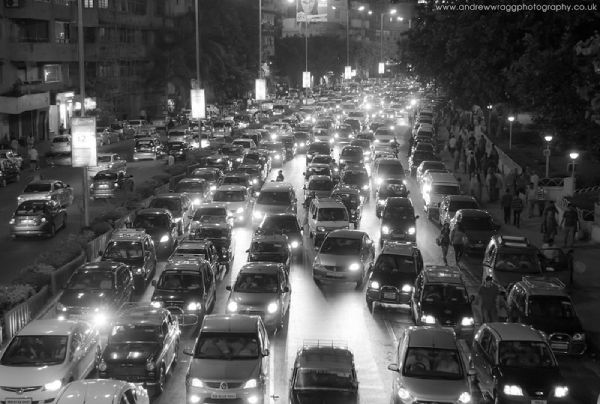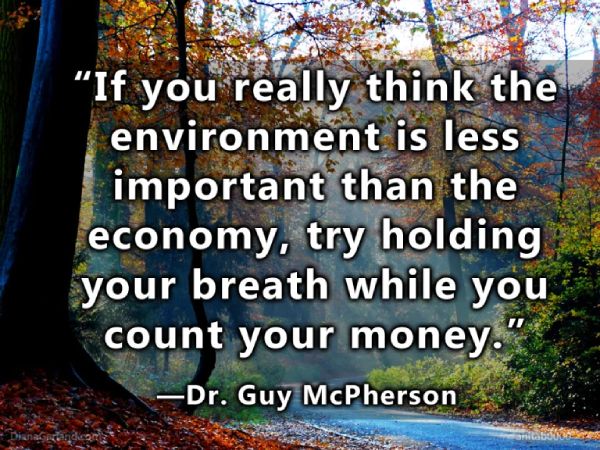For wide is the gate and broad is the road that leads to destruction, and many enter through it.
I was at my Achchi’s house where everybody’s slowly dying. I remember when her road was a dirt road and my Seeya would walk me down it, or maybe that’s a photograph, either way I remember. Now the road is paved and I’m driving a jeep, which is how it’s supposed to be, but things went terribly wrong somewhere. My Seeya had a car once and promptly drove it off a hill and never did that again. I think he had the right idea.
Now I pass a kid on a tricycle going down my old road and I wave to him. What future does this kid have? Not the same one I did. I used it up and there’s not enough future left. I want to tell him it’s a dead-end. Not the lane that ends up at my grandmother’s house. The other way. The road that leads to civilization. This civilization was always a dead end. Everybody’s slowly dying. They just don’t know it yet.
The River Of Regrets
How did we get here? How does it end? Dr. Tom Murphy has a map of the path to modernity which I’ll reproduce here. He describes the whole process as a river that gets bigger and bigger until it finally becomes a ‘raging class-5 rapid’ and ducks us over a waterfall. We’re on the way down, if you’re wondering what that tumbling feeling is. Here is Murphy’s metaphor, illustrated.
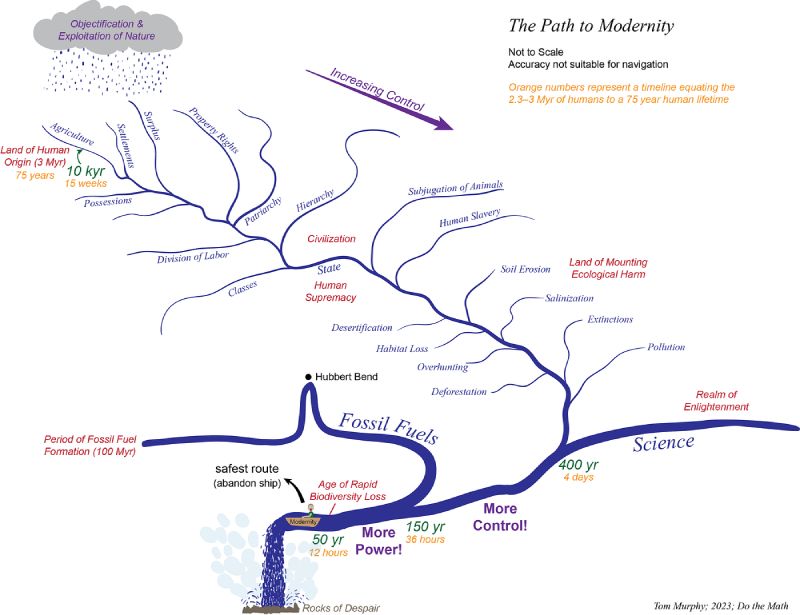
To me, the more obvious metaphor is a road. That’s how I always experienced ‘development’. Going from my grandmother’s dirt road to the highways of America always felt like progress, even though I cried bitterly about it as a child. I think I had the feeling right, but what to do? We had to go.
For most of my life Sri Lanka didn’t have highways at all, but when they did open I remember queuing up to go on them. Not to go anywhere. To just go. It felt like we were finally getting somewhere. I didn’t realize that we were just getting nowhere much faster. A few decades later the fuel ran out and you couldn’t take the highway without getting stuck on the other end. That’s where we’re all headed, eventually. Collapse is just a timing difference.
Roads are the visual definition of modernity. The more lanes the better. All roads lead to Rome, or whoever the flag-bearer of civilization is at the moment. Hence I picture Murphy’s metaphor as my grandmother’s small lane leading to a bigger road to a superhighway and then a billion car pile-up. Recently, after 20 years away from the Midwest, I went back to America and saw it for myself. The road I’d been following leads nowhere, and it made me sick to my stomach.
I found myself stuck on 18-lane highway, throwing up inside a plastic bag because I ate too many edibles. The whole road was so hot and polluted and dominating that I couldn’t stand it, I just wanted to get out, but it was impossible. That’s the human condition these days. There’s no room for humanity let alone animals on the highway of modernity. Step out and you’re roadkill. You’ve just got to keep going, till the bitter end.
The Dirt Road
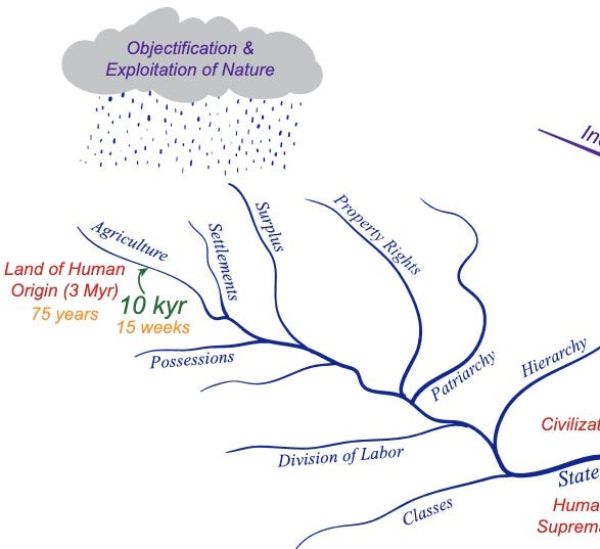
A city is a community on the arrow of time, an upward-trending arrow demanding perpetual growth. Growth is the engine of the city — if the increase stops, the city falls. Because of this, the local resources are used up quickly and the lands around the city die. The biota is stripped, then the topsoil goes, then the water. It is no accident that the ruins of the world’s oldest civilisations are mostly in deserts now. It wasn’t desert before that. A city tells itself it is a closed system that must decay in order for time to run straight, while simultaneously demanding eternal growth. This means it must outsource its decay for as long as possible.
If you look around, every ancient city ends up like this, from Polonnaruwa to Mohenjadaro back to the Fertile Crescent, which notably isn’t fertile anymore. Every city uses up its local resources and dies. By scaling up the city to global size, all we have done is use up all the resources and kill everyone. It was both predictable and unavoidable. Once you get on the highway everyone knows it sucks, but everyone just goes.
We have as little control over the process as me feeling sick on the highway. No individual can just ‘get out’, it’s too dangerous, even if we know it’s a dead end. The best we can do is vomit our fears into some other petroleum product and keep going to the bitter end. Better to live now and die then. Modernity was a Faustian bargain and I didn’t fucking make it. As the Allman Brothers sang, “I was born in the backseat of a Greyhound bus, Rollin’ down Highway 41.” It started when we put seeds in rows, and people in row houses, and young men with farming implements in phalanxes. It ends with the body horror of the highway, and there’s nothing we can do. But I’m getting ahead of myself. Let’s return to the metaphor.
The State Road
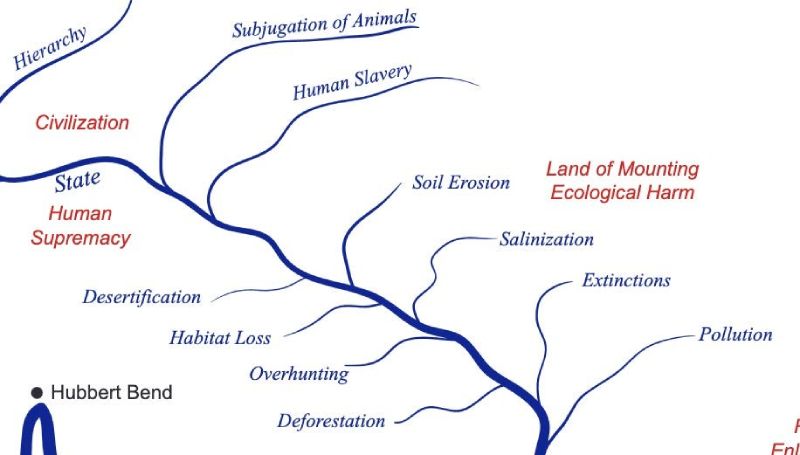
That’s the promise of the highway. It obliterates the place you’re in to get to some other place faster. It obliterates the moment you’re in to get to the future. And what is this future we’re all rushing to? Eventually your life is all highway, road highway, information superhighway, getting high and so on. You’re rushing all the time until that becomes the destination. We’re children born on the road and we’ve been on it so long we can’t remember our umbilical connection to the Earth at all. We just pave it over and roll.
The Superhighway Of Science
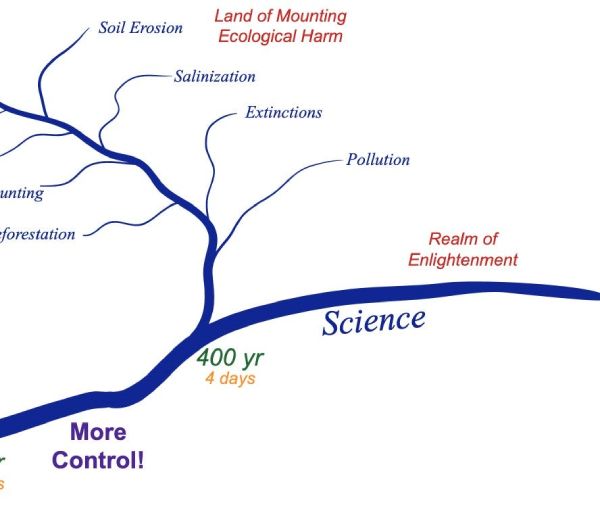
A few scientists bemoan this, but the vast majority are doing it. Any understanding that comes from science is like understanding a butterfly by killing it and pinning it to a wall. Cool, but the butterfly is dead now. There’s no road out of modernity using science. We just use science to widen the road.
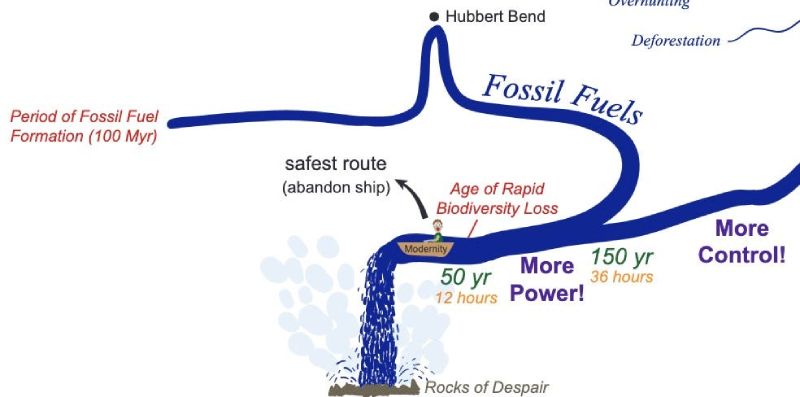
There were ads for giant hamburgers (my roasted cousins) next to ads for personal injury lawyers (my wrecked family). The lawyers advertised 1 BILLION IN RECOVERIES as if that was a good thing. How the fuck are people getting so mangled here? What am I doing here? The whole place is a literal dead-zone. It’s physically impossible for animals to exist here, nor can they pass through. There’s no trees, no shade, and no humans outside of these armored vehicles. And everybody else is supposed to develop like this? These wide roads are death incarnate. Where they lead is exactly what they look like. A dead-zone.
At this point Dr. Tom says the safest route is to abandon ship, but this is why I use the road metaphor. You can’t get out on a highway! It’s literally not allowed, and it’s physically impossible. The highway I was on was literally surrounded by high walls. It just wasn’t humanly possible. I imagined what would happen if I had to take an urgent shit. There’s simply no room for organic functions on the road we’re on.
The Billion Car Pile-Up
So now we reach our destination. What Murphy calls the ‘Rocks Of Despair’, I call a billion car pile-up. The resources are running out as pollution chokes us, a real head-on collision. I’d say good riddance but I’m in the fucking car, next to you. I wish I could just go backwards and hold my grandfather’s hand down the dusty road I grew up on, but it’s gone now. The arrow of time only goes one way. We, as a civilization, took a dirt road out of the wilderness and it led us to 18-lane highways, inexorably. If anybody else had a different idea, they got run over and we laughed at them as ‘backwards’. Little did we know.
At each stage, we thought we were getting somewhere and started going faster and faster, but ultimately we won’t get any further than my Seeya did in that old Morris Minor that he immediately crashed. We’re just driving this whole civilization off a cliff and we’re going to have to limp out and walk for the rest of our lives, like my grandparents did. And that’s the best-case scenario. We should be so lucky. For many of us and all of our high ambitions, the road just ends in ruin. Get high in traffic and tell me you don’t see it too. The future is now and the body horror is visceral. We took a long turn thousands of years ago and we can’t just turn around now. ‘We’ don’t exist and the wheel in front of us is a children’s toy. The best we can do is honk plaintively as we watch the billion-car pileup unfold.

